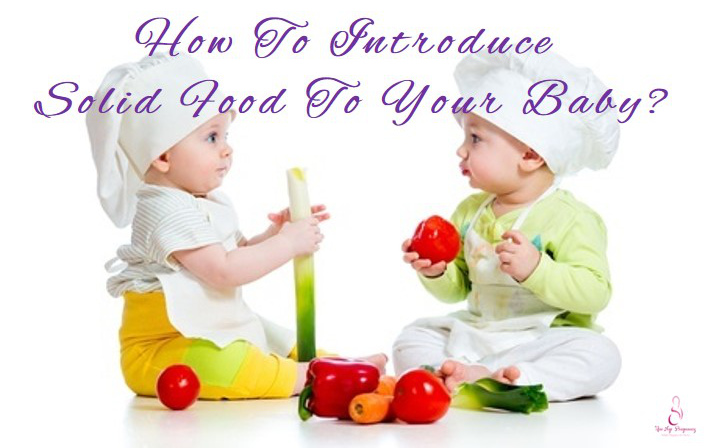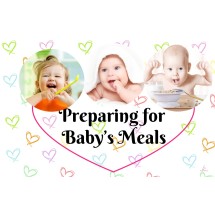
Congratulations! Your doctor says it’s finally time for your darling angel to graduate to solid foods – the “real foods” that you have the pleasure of enjoying. There’s surely a lot to be happy about, especially when you can own a huge collection of adorable snaps taken of your baby with food smeared across his cute face! With that being said, you’re also in a fix because you don’t know where to begin!
What will your baby like and what he will not like? Are you rushing your baby to consume solid foods a bit too soon? What is a good food to start with and how much should you feed him? Are you having these questions burning at the back of your mind right now? Not to worry, here are the top five strategies that will help you introduce solid foods into your baby’s diet
1. Know When Your Baby Is Ready
Your doctor may have said that you can introduce your infant to solid foods between his 4-6th month, but you must also keep a look out for certain signals that show that he is ready. Watch out for these tell-tale signs such as, increased hunger and weight gain in your baby, baby’s ability to keep food in his mouth for longer without dripping, reaching out for food on your plate, and improved control and balance while sitting upright with support. The earlier the better? No, it is not recommended to start the weaning process for your child until he reaches 4-month-old.

2. Introduce One New Food Product At A Time
When introducing your baby to solids, it is important that you go easy on the variations. Doing this will help you understand the possible food allergies and intolerance your baby may have. Keep a minimum of 3-4 days window period for observation before feeding something new to your baby, as some foods may have delayed reactions. A common risk factor for food allergies in babies is feeding them solids too soon (earlier than four months). If your baby is displaying signs of a food allergy, consult a GP at the earliest.
3. Keep The Food Texture In Mind
Introduce solid foods with varying textures gradually in your baby’s diet. Apart from breast milk or formula, you can begin by feeding baby cereal to your baby with a spoon, twice a day. Slowly reduce the amount of liquid that you mix with the cereal, it will get your baby to learn how to chew and swallow. Once he’s used to eating cereals, slowly introduce him to pureed veggies, fruits and meat. By the 8-10th month, you can introduce your baby to small portions of chopped/mashed veggies, fruits, cheese, pasta, bread, and other foods that the rest of your family is eating.

4. Know What To Avoid
Certain foods considered nutritious for us adults can be harmful to your little one. For example, cow’s milk can lead to iron deficiency in your infant – a nutrient essential for hemoglobin formation and thus, for healthy blood flow. You must also avoid feeding honey to your baby because the spores contained in honey can make him susceptible to infant botulism, which can result in muscle weakness and breathing trouble. Avoid added salt and sugar in your baby’s food as it doesn’t provide any nutritional benefit to the baby’s development. It will also help to form healthy eating habits in your child from the very start. By all means, avoid food like nuts, raisins, popcorn, seeds and hard sweets that can choke your baby.
There are some foods that baby under one should avoid, due to the risk of allergic reactions. Check out what these allergenic foods are, and avoid them for now.
5. Feed The Right Way
It’s true that most habits get formed early in life, and that happens during mealtime too. Developed a mealtime pattern that can help your child gain independence and also, better eating habits.
i. Make your baby sit on a high chair
ii. Place a bib around his neck
iii. Buckle up the belt
iv. Provide baby-friendly tableware
Watch out for signs that your baby is full such as turning his face away from the food, bending backward, crying, spitting, etc. Do not force food down your baby’s throat just to make him finish everything that you have prepared. It is a good idea to let your baby explore food by letting him hold his spoon and play around with the food. The mess is a great way to show that he is exploring the food and learning how to feed himself.
It is important to be consistent in your effort. But if something doesn’t work well, try out different methods such as changing the choice of ingredients used to prepare your baby’s food. Consult your pediatrician if you are uncertain about the choice of foods to wean your baby.
By Aradhana
Aradhana is from India. She is a veteran writer on topics concerning parenting, child nutrition, wellness, health and lifestyle. As a regular contributor to popular sites like Huffington Post, Natural news, Elephant journal, Thehealthsite, Naturally Savvy, Curejoy and MomJunction.com, Aradhana writes to inspire and motivate people to adopt healthy habits and live a stress-free lifestyle.






